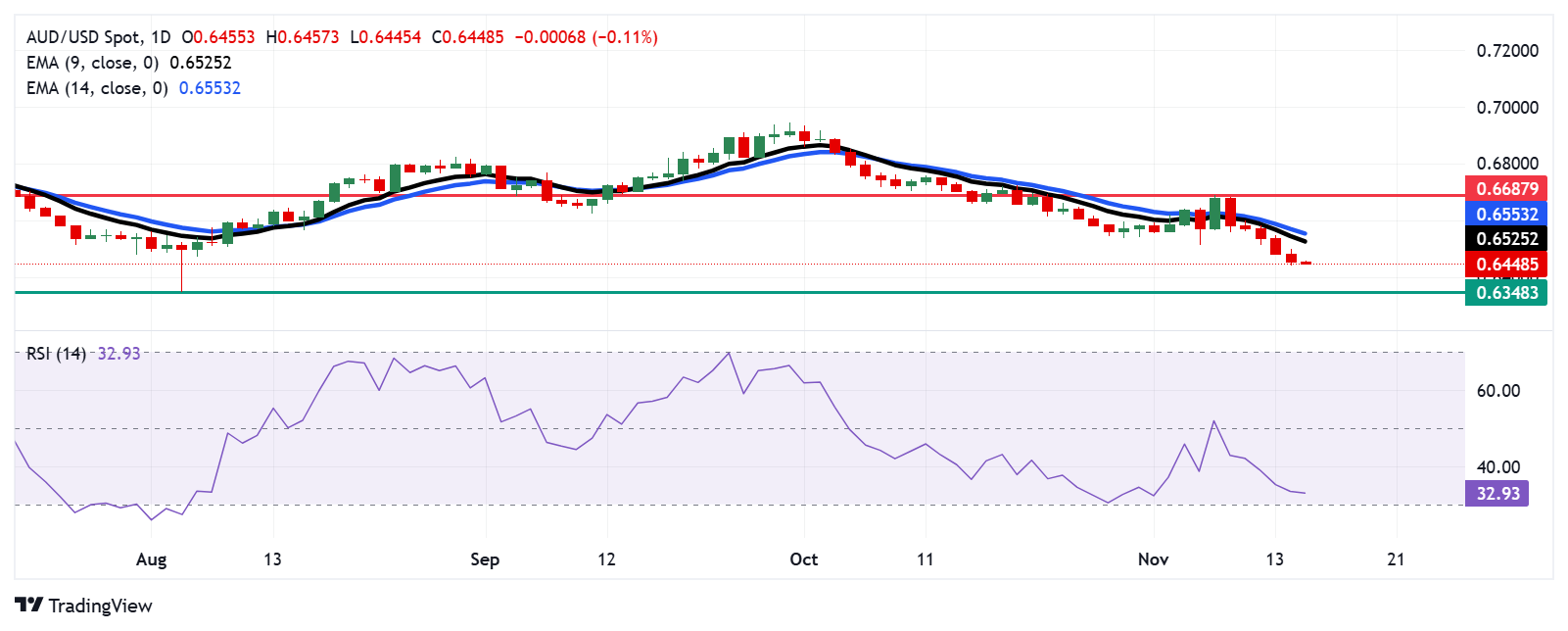- The Australian Dollar remains under pressure due to recent weak economic data.
- RBA Governor Bullock stated that current interest rates will remain unchanged until the bank gains confidence in the inflation outlook.
- Fed Chairman Powell noted that the performance of the US economy has been “remarkably good”, providing flexibility to reduce interest rates gradually.
The Australian Dollar (AUD) continues its decline for the sixth consecutive session on Friday, hovering around three-month lows against the US Dollar (USD). The recent downward trend in the AUD/USD pair is largely due to key economic data from Australia.
However, the Australian Dollar’s decline may be limited due to less dovish comments from Reserve Bank of Australia (RBA) Governor Michele Bullock on Thursday. Bullock stated that current interest rates are sufficiently restrictive and will remain at this level until the central bank gains confidence in the inflation outlook.
The US dollar remains stable near its new 2024 highs, despite signs of a slowdown in the Trump trades. The Dollar Index (DXY), which tracks the performance of the US dollar against six major currencies, is around 107.06, marking its highest level since November 2023.
Markets are now focused on US October retail sales data, due to be released on Friday, along with comments from Federal Reserve officials. On Thursday, Fed Chair Jerome Powell noted that the recent performance of the U.S. economy has been “remarkably good,” allowing the Fed to gradually reduce interest rates.
Australian Dollar Extends Losing Streak as US Dollar Hits New 2024 Highs
- The US Producer Price Index (PPI) rose 2.4% year-on-year in October, up from a revised 1.9% increase in September (previously 1.8%) and beating market expectations of 2.3%. Meanwhile, the core PPI, which excludes food and energy, rose 3.1% year-on-year, slightly above the 3.0% anticipated.
- Australia’s seasonally adjusted unemployment rate remained stable at 4.1% in October for the third consecutive month, matching market expectations. However, employment change data revealed only 15.9K new jobs added in October, which fell short of the 25.0K anticipated.
- Australian consumer inflation expectations fell to 3.8% in November, from 4.0% the previous month, hitting the lowest level since October 2021.
- St. Louis Federal Reserve Bank (Fed) President Alberto Musalem commented Wednesday that persistent inflation challenges make it difficult for the Fed to continue reducing rates. Musalem redirected attention to the overall strength of the U.S. labor market, seeking to ease concerns about inflation’s resistance to the Fed’s efforts to reduce it.
- Federal Reserve Bank of Kansas City President Jeffrey Schmid highlighted potential challenges to lowering interest rates. Schmid also criticized market participants who continue to expect a return at near-zero rates, calling their expectations unrealistic.
- The US Consumer Price Index (CPI) rose 2.6% year-on-year in October, in line with market forecasts. Meanwhile, the core CPI, which excludes the more volatile food and energy components, rose 3.3% as expected.
- Australian Prime Minister Anthony Albanese shared in a radio interview on Wednesday that he discussed trade with US President-elect Donald Trump during a phone call last week. Albanese informed Trump that the United States has a trade surplus with Australia and emphasized that it is in Washington’s interest to “trade fairly” with its ally. Meanwhile, the defense minister highlighted Australia’s significant investment in security.
- Last week, China’s latest stimulus measures fell short of investor expectations, further depressing the demand outlook for Australia’s largest trading partner and weighing on the Australian dollar. China announced a 10 trillion yuan debt package to ease local government financing pressures and support struggling economic growth. However, the package stopped short of implementing direct economic stimulus measures.
Technical Analysis: Australian Dollar falls near 0.6500, oversold levels
AUD/USD is trading near 0.6460 on Friday. An analysis of the daily chart shows short-term bearish pressure as the pair remains below the nine-day exponential moving average (EMA). Additionally, the 14-day Relative Strength Index (RSI) is slightly above 30, indicating possible oversold conditions. If the RSI falls below 30, it could signal an oversold situation, suggesting a possible upward correction.
The AUD/USD pair may find a key level near 0.6400 for support. A break below this psychological threshold could amplify bearish pressure, potentially taking the pair towards the yearly low of 0.6348, last touched on August 5.
Immediate resistance lies at the psychological level of 0.6500. A break above this level could lift the pair towards the nine-day EMA at 0.6525, followed by the 14-day EMA at 0.6553. Breaking through these EMAs could pave the way for a move towards the three-week high of 0.6687.
AUD/USD: Daily Chart
Australian Dollar PRICE Today
The table below shows the percentage change of the Australian Dollar (AUD) against major currencies today. Australian dollar was the weakest currency against the Euro.
| USD | EUR | GBP | JPY | CAD | AUD | NZD | CHF | |
|---|---|---|---|---|---|---|---|---|
| USD | -0.13% | -0.07% | 0.17% | 0.00% | -0.08% | -0.07% | -0.12% | |
| EUR | 0.13% | 0.06% | 0.28% | 0.15% | 0.05% | 0.05% | 0.02% | |
| GBP | 0.07% | -0.06% | 0.22% | 0.09% | -0.01% | -0.01% | -0.05% | |
| JPY | -0.17% | -0.28% | -0.22% | -0.13% | -0.25% | -0.25% | -0.27% | |
| CAD | -0.01% | -0.15% | -0.09% | 0.13% | -0.11% | -0.09% | -0.13% | |
| AUD | 0.08% | -0.05% | 0.01% | 0.25% | 0.11% | 0.00% | -0.04% | |
| NZD | 0.07% | -0.05% | 0.00% | 0.25% | 0.09% | -0.01% | -0.04% | |
| CHF | 0.12% | -0.02% | 0.05% | 0.27% | 0.13% | 0.04% | 0.04% |
The heat map shows percentage changes for major currencies. The base currency is selected from the left column, while the quote currency is selected from the top row. For example, if you choose the Australian Dollar from the left column and move along the horizontal line to the US Dollar, the percentage change shown in the box will represent the AUD (base)/USD (quote).
The Australian Dollar FAQs
One of the most important factors for the Australian Dollar (AUD) is the level of interest rates set by the Reserve Bank of Australia (RBA). As Australia is a resource-rich country, another key factor is the price of its largest export, iron ore. The health of the Chinese economy, its largest trading partner, is a factor, as is inflation in Australia, its growth rate and the Balance of Trade. Market sentiment, that is, whether investors bet on riskier assets (risk-on) or seek safe havens (risk-off), is also a factor, with the risk-on being positive for the AUD.
The Reserve Bank of Australia (RBA) influences the Australian Dollar (AUD) by setting the level of interest rates that Australian banks can lend to each other. This influences the level of interest rates in the economy as a whole. The RBA’s main objective is to maintain a stable inflation rate of 2%-3% by adjusting interest rates up or down. Relatively high interest rates compared to other major central banks support the AUD, and the opposite for relatively low ones. The RBA can also use quantitative easing and tightening to influence credit conditions, with the former being negative for the AUD and the latter being positive for the AUD.
China is Australia’s largest trading partner, so the health of the Chinese economy greatly influences the value of the Australian Dollar (AUD). When the Chinese economy is doing well, it buys more raw materials, goods and services from Australia, which increases demand for the AUD and drives up its value. The opposite occurs when the Chinese economy does not grow as fast as expected. Therefore, positive or negative surprises in Chinese growth data usually have a direct impact on the Australian Dollar.
Iron ore is Australia’s largest export, with $118 billion a year according to 2021 data, with China being its main destination. The iron ore price, therefore, may be a driver of the Australian dollar. Typically, if the price of iron ore rises, the AUD also rises as aggregate demand for the currency increases. The opposite occurs when the price of iron ore falls. Higher iron ore prices also tend to result in a higher likelihood of a positive trade balance for Australia, which is also positive for the AUD.
The trade balance, which is the difference between what a country earns from its exports and what it pays for its imports, is another factor that can influence the value of the Australian dollar. If Australia produces highly sought-after exports, its currency will gain value solely from the excess demand created by foreign buyers wanting to purchase its exports versus what it spends on purchasing imports. Therefore, a positive net trade balance strengthens the AUD, with the opposite effect if the trade balance is negative.
Source: Fx Street
I am Joshua Winder, a senior-level journalist and editor at World Stock Market. I specialize in covering news related to the stock market and economic trends. With more than 8 years of experience in this field, I have become an expert in financial reporting.








